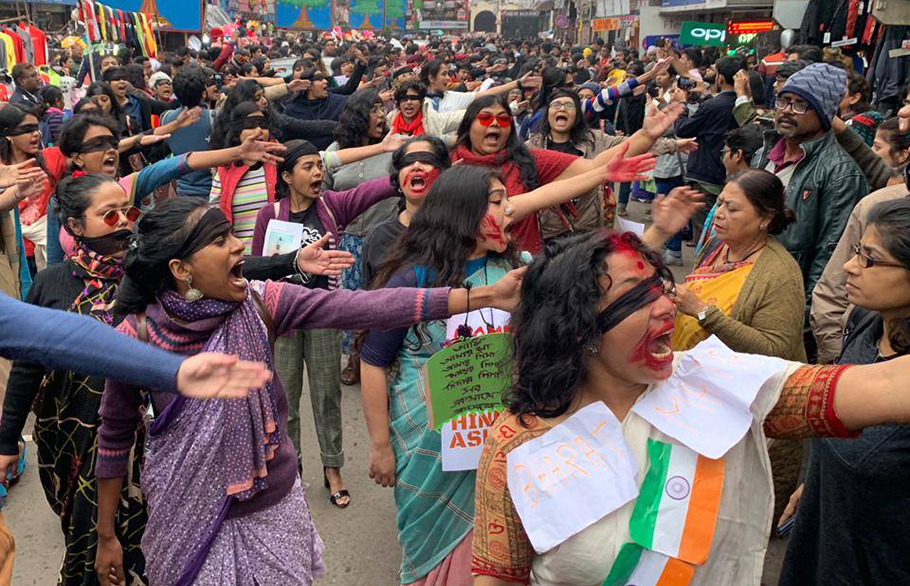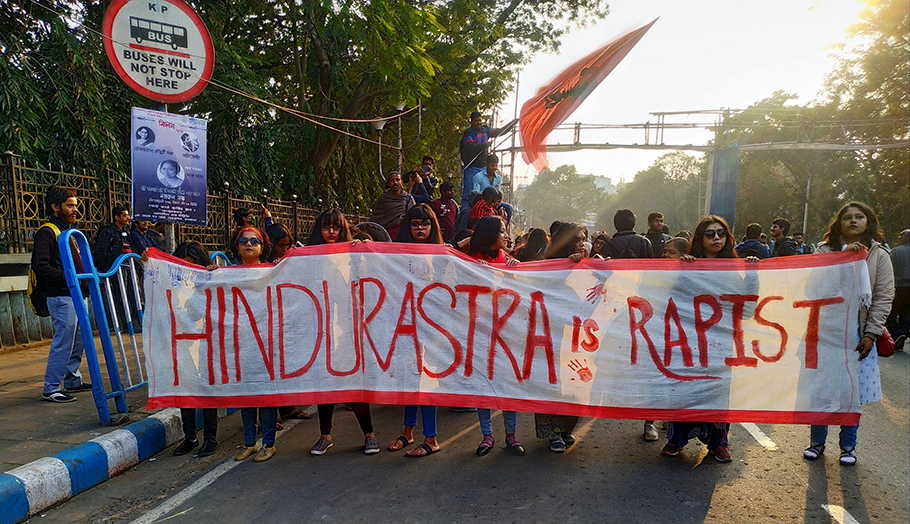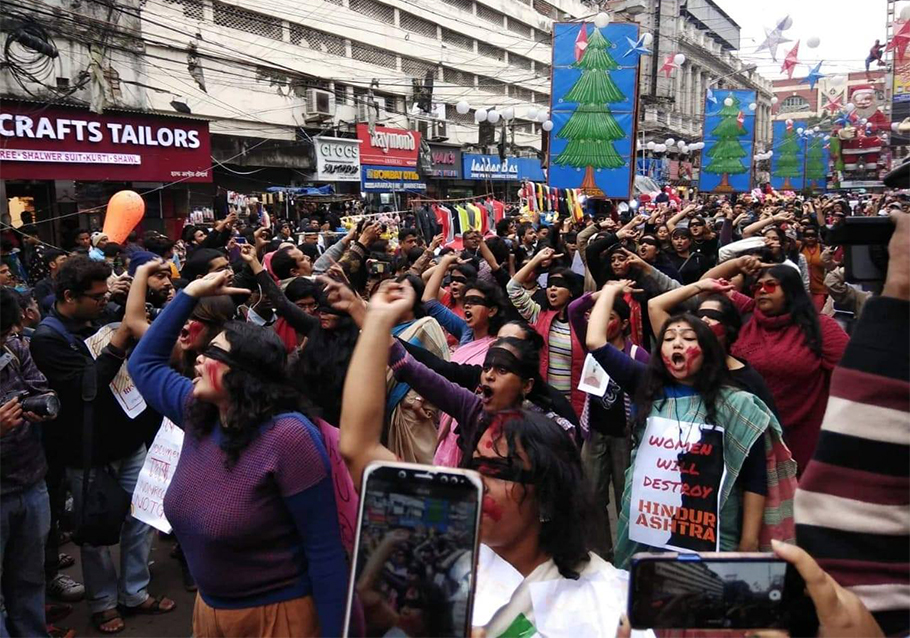
- Home
- News
- Analysis
- States
- Perspective
- Videos
- Education
- Entertainment
- Elections
- World Cup 2023
- Features
- Health
- Business
- Series
- Economy Series
- Earth Day
- Kashmir’s Frozen Turbulence
- India@75
- The legend of Ramjanmabhoomi
- Liberalisation@30
- How to tame a dragon
- Celebrating biodiversity
- Farm Matters
- 50 days of solitude
- Bringing Migrants Home
- Budget 2020
- Jharkhand Votes
- The Federal Investigates
- The Federal Impact
- Vanishing Sand
- Gandhi @ 150
- Andhra Today
- Field report
- Operation Gulmarg
- Pandemic @1 Mn in India
- The Federal Year-End
- The Zero Year
- Premium
- Science
- Brand studio
- Home
- NewsNews
- Analysis
- StatesStates
- PerspectivePerspective
- VideosVideos
- Entertainment
- ElectionsElections
- Sports
- Loading...
Sports - Features
- BusinessBusiness
- Premium
- Loading...
Premium

Rapist is you: Women protesters vs a macho Hindu rashtra

Blindfolded, they shouted, “The oppressive state is a rapist.” “This is rape, the rapist is you”. A group of women marched in coordinated rhythm, challenging what they called “hyper-masculine attitude of the state”. On January 4, the busy streets of Kolkata’s Esplanade, and later Jadavpur, erupted in a fresh wave of resistance — Dhorshok Tumi-i (The...
Blindfolded, they shouted, “The oppressive state is a rapist.” “This is rape, the rapist is you”. A group of women marched in coordinated rhythm, challenging what they called “hyper-masculine attitude of the state”.
On January 4, the busy streets of Kolkata’s Esplanade, and later Jadavpur, erupted in a fresh wave of resistance — Dhorshok Tumi-i (The rapist is you), the Bengali version of Chilean feminist anthem, Un violador en tu camino (A rapist in your path), written in protest against violence on women.
The rapist is you
Balatkari tum ho
Tumi-i dhorshok
Flash mobs and protests, part of a movement to make masses aware of the ‘rape culture’ in the society, have hit more than 200 cities across the world. Videos of the protest have gone viral, adding momentum to the movement. And the protesters have claimed that the governments have left vulnerable sections of the society in dire straits.
Patriarchy is a judge who judges us for being born
and our punishment is the violence you don’t see.
It’s femicide, impunity for my murderer,
it’s disappearance, it’s rape.
And it wasn’t my fault, where I was, or how I dressed.
The rapist is you, the rapist is you.
It’s the police, the judges, the state, the president.
The oppressive state is a macho rapist.
This is the literal translation of a part of the Latin song.
The song was launched as a scathing attack on the society, which the protesters claim, is neck-deep in misogyny and the rape culture that gives no hope of a better tomorrow. It roars against the failure of the state to bring convicts to justice. It questions the police, the judiciary, the authorities and those at the helm of it.
The anthem, written by a Chilean feminist group Las Tesis, was first performed in the port city of Valparaiso last November, sending a strong message against the macho violence culture. Soon, it spread across Latin America, United States and Europe.
A key part of the movement was a demonstration by a 60-strong crowd of women performing the anthem outside a court in New York City during the trial of disgraced Hollywood mogul Harvey Weinstein.
And finally, it reached India, where it was first performed in the national capital New Delhi and then in Kolkata.
Dipanwita Paul, one of the members of the flash mob, tells The Federal that the movement was inspired by the feminist intervention that started in Chile. “El violador eres tu (The rapist is you) went around in various parts of the world. That was the foundation of this feminist intervention we are doing right now in Kolkata,” she says.
Today at Manhattan Criminal Court, dozens of women showed up to protest Harvey Weinstein with the battle cry, “Un Violador en it Camino” or “A Rapist in Your Path” pic.twitter.com/MMVu12paSB
— Michelle Garcia (@mzMichGarcia) January 10, 2020
Rising Crimes Against Women
The movement finds significance against the backdrop of widespread violence against women in the country. According to the recent National Crime Records Bureau (NCRB) data, 3,78,277 cases of crimes against women were reported in 2018, steadily rising from 3,59,849 cases in 2017 and 3,38,954 in 2016.
According to many activists, that’s just the tip of the iceberg since the numbers pertain only to reported incidents of crime, whereas it is alleged that a massive chunk of these cases remain unreported.
The protesters singing Dhorshokder saja hoyna (impunity for my rapist) reflects a bitter truth that is supported by the conviction rate in our country. NCRB data shows the conviction rate in rape cases was 25.4, which is a mere one-fourth of the total number of rape cases that underwent trial in 2018.
“We wanted to attack the rape culture, and the hyper-masculine and macho rapist attitude of the state and the system. We are not only addressing the physical damage of rape but the continuous rape culture that is propagated around us. The rape that the system does on people, especially women, the LGBTQI persons, the most vulnerable section of people, the lower classes and the disabled,” says Paul.
“We think it is very much relevant in the current socio-political milieu of India,” she says. “Firstly, after the Hyderabad rape, the farce that we put up as a nation, that we sort of aspire towards gender equality, was again exposed. There were a series of violent crimes against women that came forth.”
She was referring to the brutal rape and murder of a veterinary doctor in Hyderabad in November 2019 and the subsequent encounter killing of the accused rapists.
Against Fascist Hindutva too
One striking aspect witnessed during the recent protests in Kolkata was its attack against the “Hindutva fascism”, with marchers holding banners that read “Hindu rashtra is rapist” and “Women will destroy Hindu rashtra”, signifying that the ideology too was rapist — all during Prime Minister Narendra Modi’s visit to the city and as an extension of the widespread protests against the recently amended Citizenship Act (CAA).

Protester, Dyuti Mukherjee, says the Chilean anthem from which ‘Dhorshok Tumi-i’ has been adapted is not only feminist, but also “strongly anti-fascist” in nature.
“The anthem talks about how rape and rape culture is an inevitable outcome of a fascist regime. The chant has travelled the world mainly as a feminist anthem against rape but our current political context demanded we preserve the original anti-fascist intent of the chant,” she says.
“Dhorshok Tumi-i talks about rape as a tool of large scale coercion of communities and fearmongering tactics,” she adds.
“We are receiving a lot of trolls on the Hindu Rashtra bit. These trolls are purposefully conflating ‘Hindu Rashtra’ with ‘Hinduism’. That is not at all the case. Hindu Rashtra is a term pioneered by the likes of (Vinayak Damodar) Savarkar (BJP’s founding ideologist) and Hindu nationalists like him. It views Hinduism as a homogenised, monolithic presence, which stands opposite Islam. But that is the idea of ‘Hindutva’, not ‘Hinduism’. Hindutva does not exist. It’s a figment of political imagination,” says Mukherjee.
“The idea of Hindu Rashtra is, therefore, standing directly opposed to the idea of India. India, when it came into being as a geopolitical entity, was envisaged as a secular, democratic, and socialist nation. Hindu Rashtra is bigoted, dictatorial, and inherently fawning at the feet of Big Money. Hindu Rashtra can survive only when it has marked out several groups of people as second-class citizens. The fight against Hindu Rashtra is also a fight to save our Constitution and the India we had inherited,” she adds.
Neglected Citizens
The banners also showcased other demands of the women, including the scrapping of the Transgenders Act, 2019, and their denial to CAA, National Register of Citizens (NRC) and others.
Speaking about the NRC, Mukherjee says, “Dhorshok Tumi-i speaks about the rape and murder of women and gender minorities in the name of religion, caste, honour and war. It speaks about the millions of women who will be doubly affected through the exercise of NRC because, in South Asia, a large majority of women do not hold any acceptable proof of citizenship — they are treated as “objects” — paraya dhan (wealth of another), amanat (security deposit), etc.”

Protesters also highlighted the alleged use of rape as a political tool in India to suppress political voices and the plight of women.
“Rape has historically been used as a political tool of violence to repress women and the population altogether. We all know about Kunan Poshpora and what Kashmiri women are facing. So we wanted to talk about the violent nature of the state and the oppressive, the diminutive and the completely dehumanising attack on the population by the method of rape that is faced mostly by women and people of the LGBTQI sect,” said Paul.
Kunan Poshpora refers to an alleged mass rape in the twin villages of Kunan and Poshpora in Kashmir’s Kupwara district in 1991.
“We recognise that rape is intrinsically linked with notions of community, honour, and ownership — it is not so much about sex as it is about power. In the current political landscape, rape is as much a class/caste/citizenship/nationalistic issue as it is of sexual violence — which in itself is a fascist trait if interpreted loosely,” Mukherjee says.
She goes on to add that the movement has another dimension — gender violence.
“The original chant says ‘The state is a male rapist’. Like the hyper-masculine rapist that inflicts violence as a show of power on ‘weaker’ genders, the government is flexing its muscles to coerce minorities in submission,” she says. “Dhorshok Tumi-i is a chant against both these macro and micro-level cultures of aggression.”

